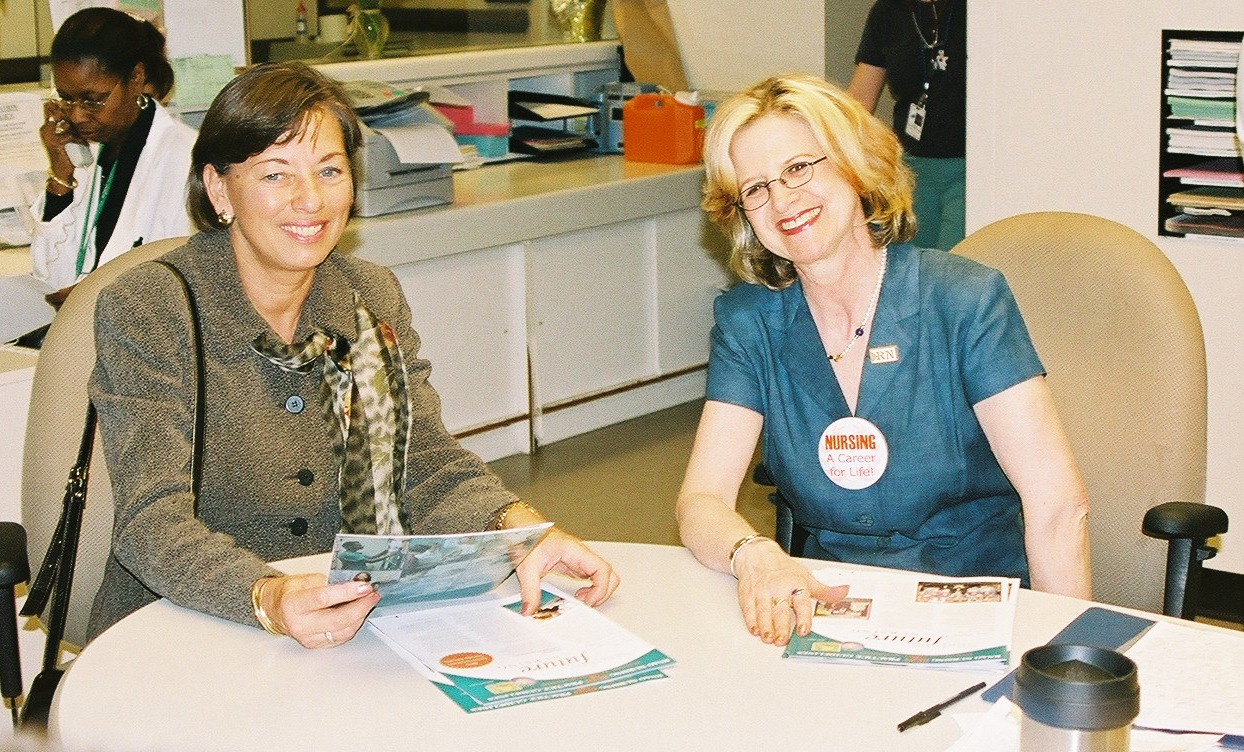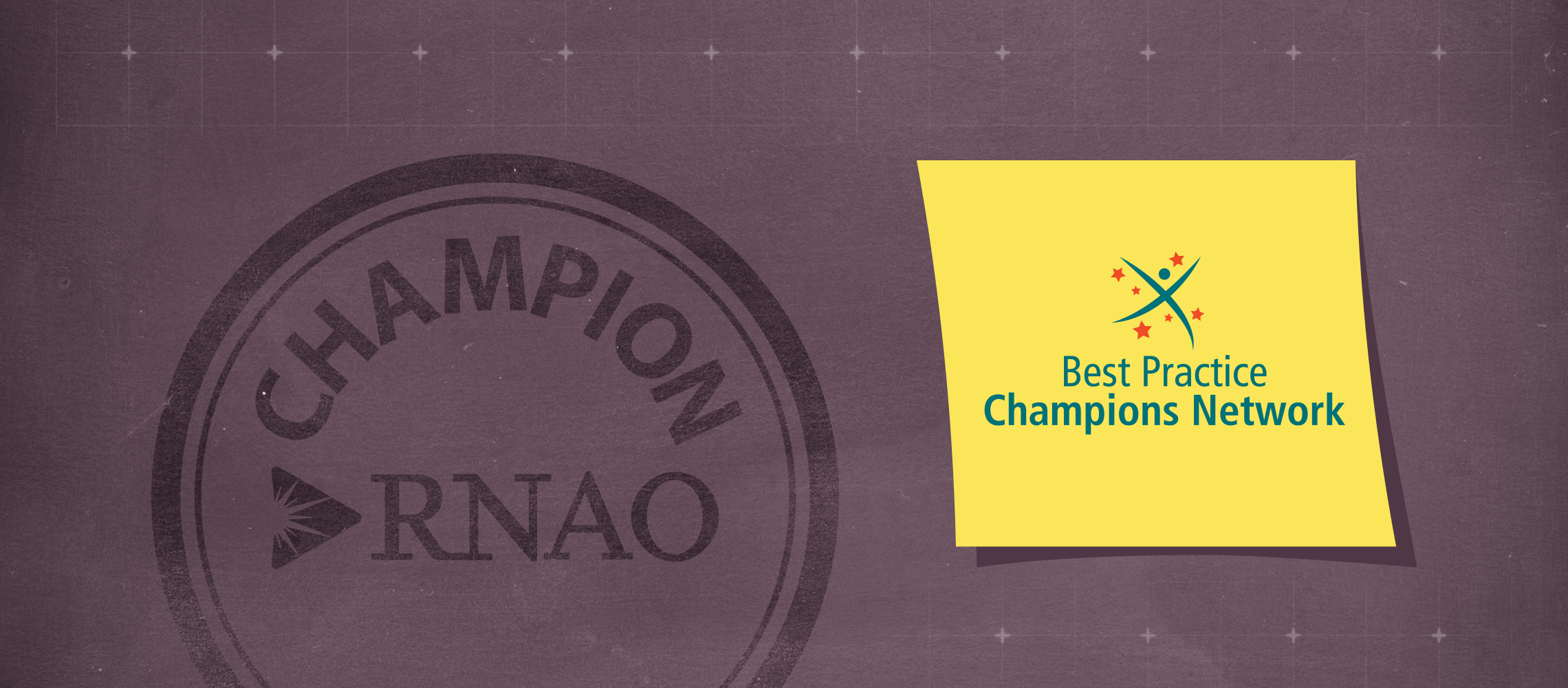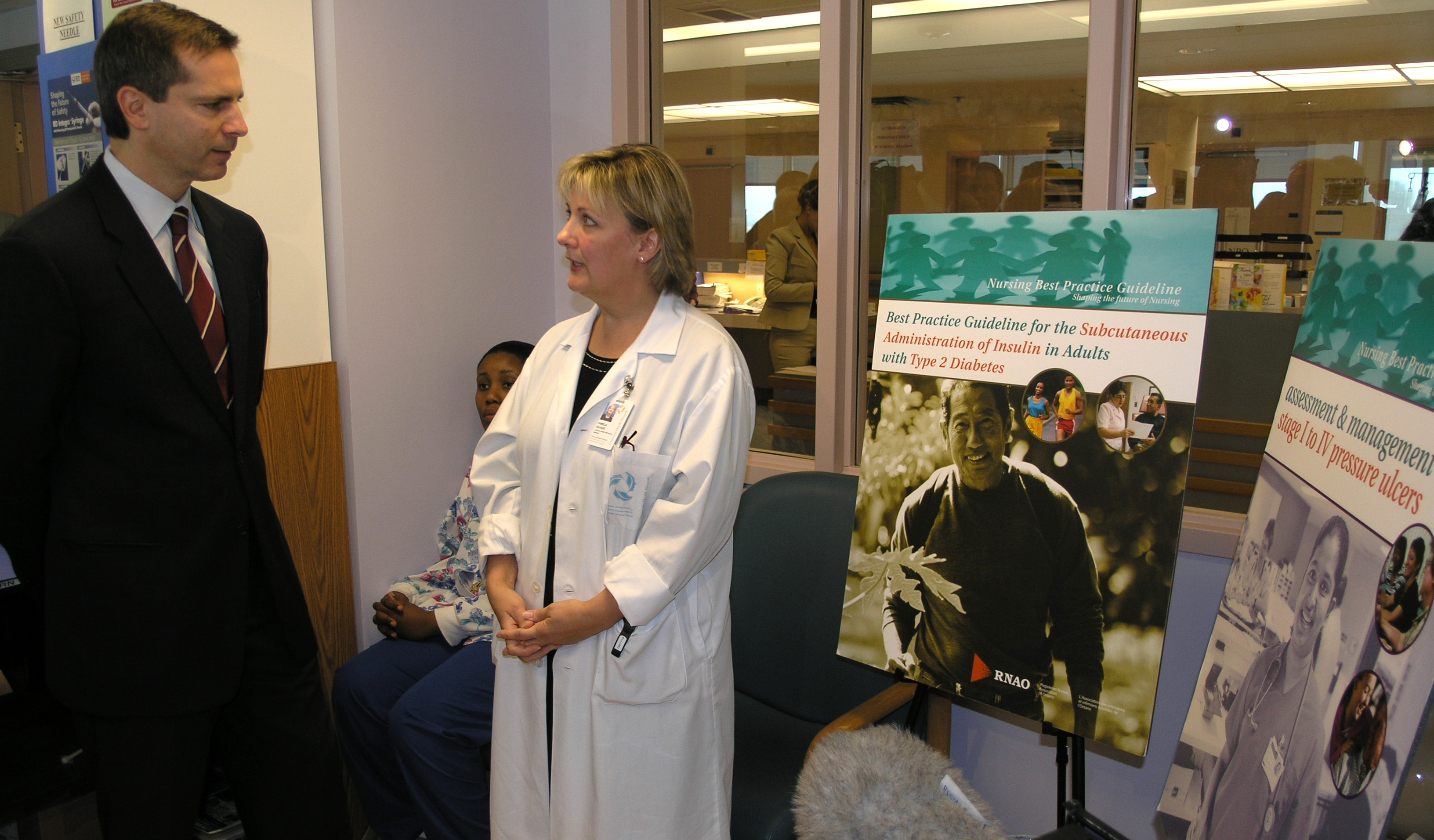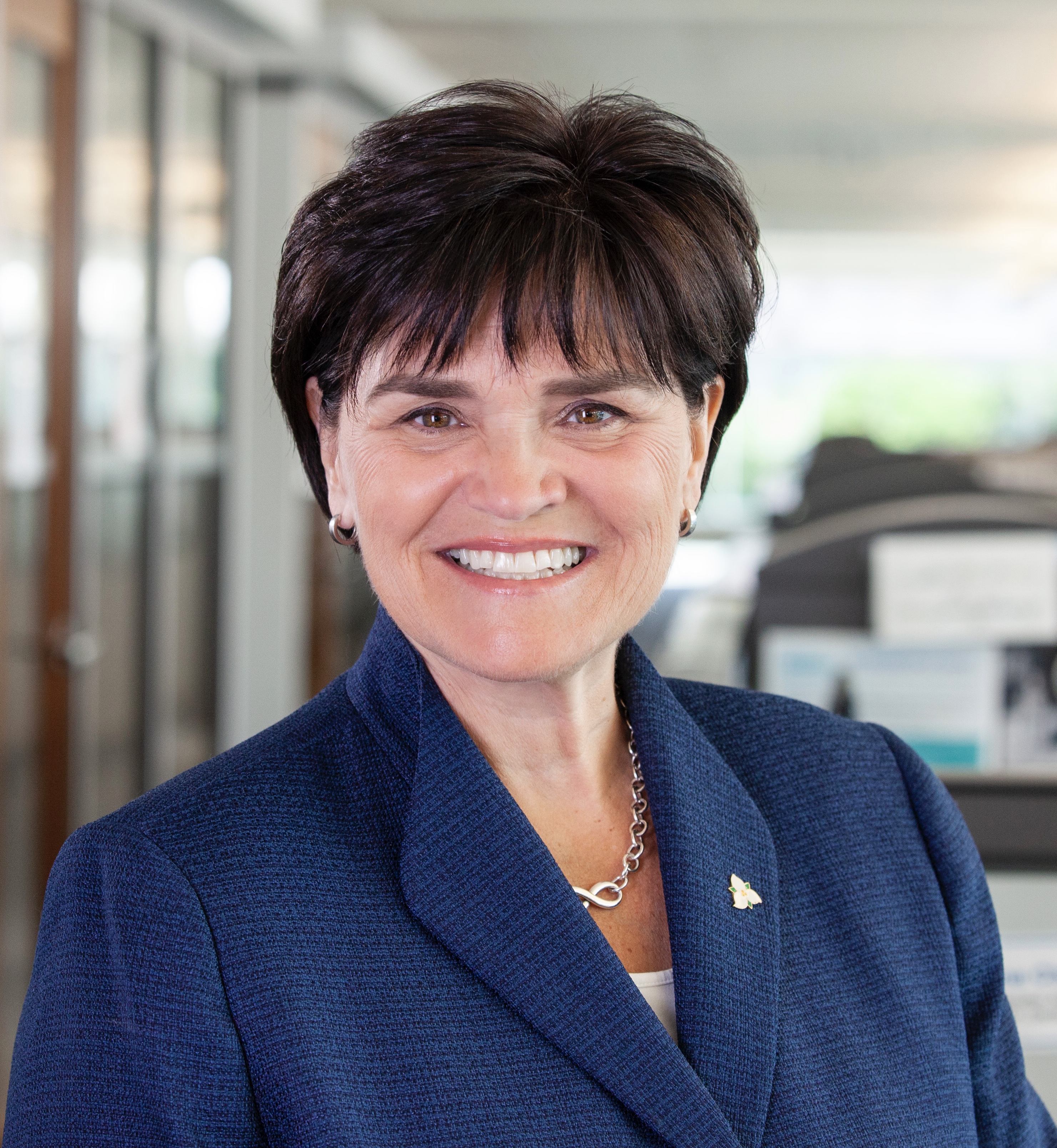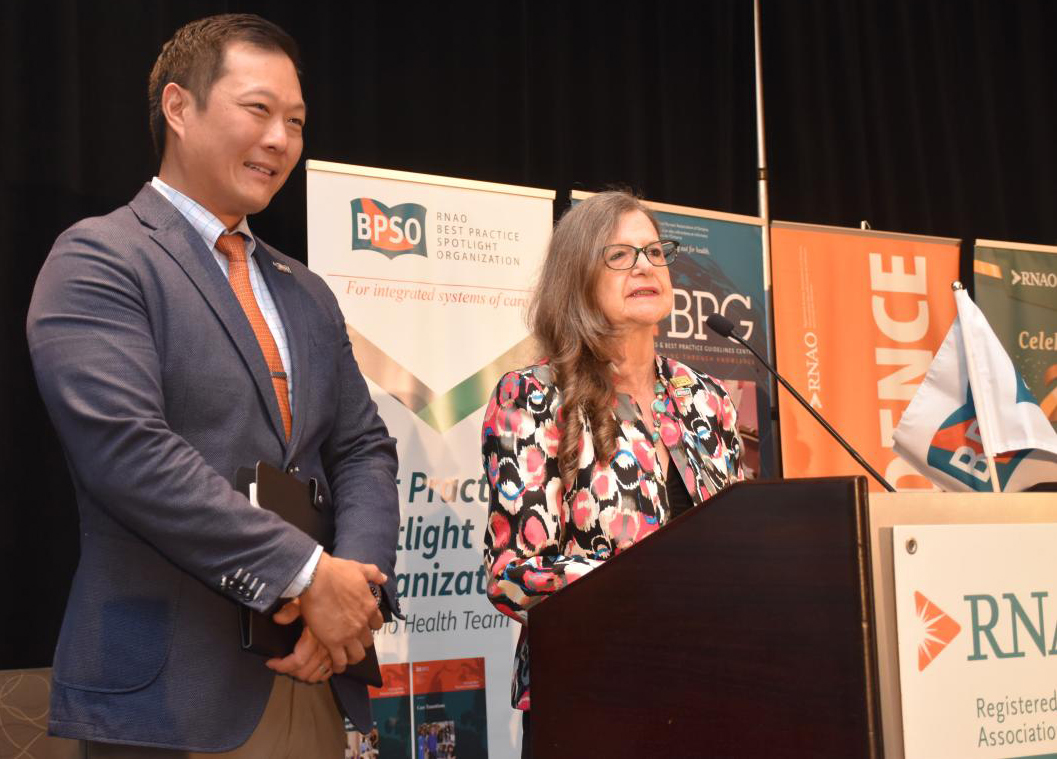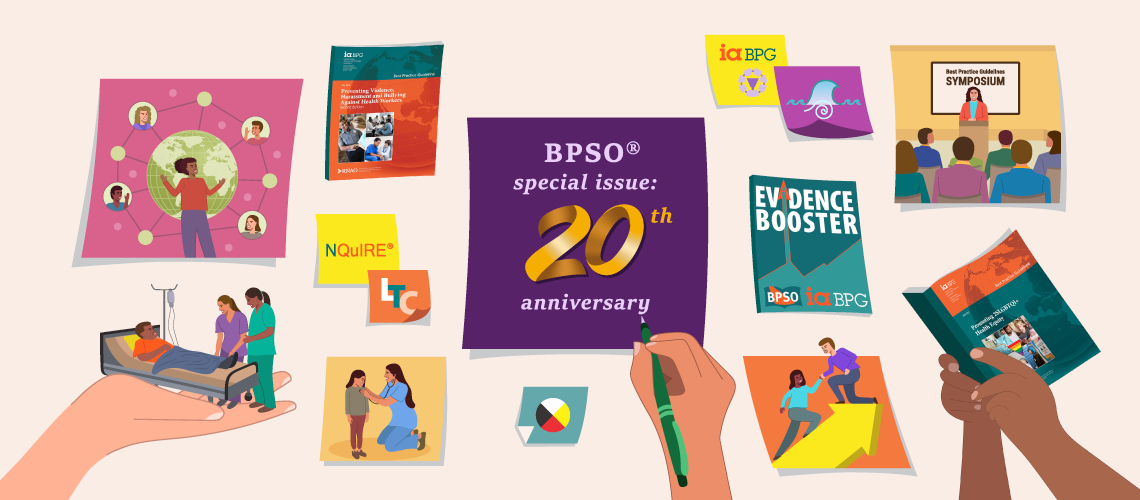
At the annual Best Practice Spotlight Organization® (BPSO®) Symposium in Toronto this fall, RNAO CEO Dr. Doris Grinspun, founder of the internationally renowned program, addressed a room of more than 200 in-person attendees and hundreds more online. It all “started with a proposal from a young nurse with dreams in her head,” she said of the Best Practice Guidelines (BPG) Program that has since grown into a social movement of science, with more than 1,500 BPSOs implementing RNAO’s best practice guidelines around the world (search our interactive map for more information).
She recalls how her first conversations about BPGs happened while she was doing work with the Pan American Health Organization as director of nursing at Toronto’s Mount Sinai Hospital through the early 1990s. Grinspun’s vision came to fruition when she joined RNAO as its executive director in 1996 and pushed to change nursing for the better. “(It’s now) a powerful movement we’ve shaped together…for nurses, other health professionals and the public.”
RNAO’s BPSO program has become the gold standard for a purposeful, social movement of science that relies on a conscious and intentional approach to growth that involves knowing when to accelerate change and when to slow down and let it happen organically (referred to by Grinspun as purposeful evolution in RNAO’s 2018 book about the program, Transforming Nursing Through Knowledge). This approach is one of the reasons why diverse care providers and political leaders of all stripes have supported RNAO’s BPG and BPSO programs since 1998 and 2003, respectively.
The 1990s was a time of widespread disruption in Ontario’s health system as a result of restructuring and nursing layoffs. And it was during this uncertainty that RNAO took on a leading role with support from the Ontario government to reinvigorate the profession and ensure nurses had the knowledge and skills they needed to provide care in an increasingly complex environment.
During a recent conversation with RNJ about the 20th anniversary of the program, Elizabeth Witmer, former Conservative health minister from 1997 and 2001, shared her recollection of the government’s motivation to fund the BPG program: “We wanted to do everything we could to retain nurses, attract more nurses to the profession and improve their working conditions,” says Witmer, who is now retired and a member of the board of trustees for St. Mary’s General Hospital in Kitchener.
We wanted to do everything we could to retain nurses, attract more nurses to the profession and improve their working conditions.
Following a robust proposal by Grinspun, multi-year funding was announced and allocated to RNAO in 1998 for the development, pilot implementation, evaluation and dissemination of BPGs. The funding and partnership with the provincial government has continued for over two decades, regardless of the party in power. This speaks to the value, importance and impact of the program. Indeed, while this year marks the 20th anniversary of BPSOs, next year will mark 25 years since the BPG program was launched.
Champions support BPG implementation
With the government funding, RNAO developed its first four BPGs, focused on incontinence, constipation, falls prevention and pressure ulcers. They were piloted in 2001 and publicly launched a year later. It was also at this time that the association established its Best Practice Champions Network®, with nurses from various workplaces trained by RNAO to coach colleagues in implementing the BPGs.
As part of the network, nurses became champions by participating in one-day, in-person workshops, later supplemented with a self-directed eLearning program and an eventual virtual learning series during the pandemic. The curriculum prepares champions with numerous tools and strategies to promote and support the implementation of BPGs in their organizations.
“By networking, sharing experiences and building strong ties between organizations, these champions are influencing change at the point of care,” Grinspun told RNJ when news of the growing program was first published in 2005. Fast-forward two decades to the fall of 2023 and the launch of a revitalized champions program. The Champions Blended Learning Series is a training course that gives champions strategies for driving change and mobilizing action in their workplaces or academic settings. Read more about the exciting new curriculum and what inspires champions in our feature, Leading by example.
As the growing network got off the ground and continued to expand by the day (there are now more than 150,000 champions around the world), RNAO’s BPG program also continued to grow and more clinical guidelines were under development. The evidence-based Toolkit: Implementation of Best Practice Guidelines (published in 2002) was available to guide organizations through the implementation process. Around that time, Dalton McGuinty was elected premier of Ontario, and he appointed George Smitherman as his minister of health and long-term care. The shift to a Liberal government did not impact the funding agreement between RNAO and the province. That's because McGuinty was already well aware of the BPG program as leader of the official opposition at Queen’s Park prior to his election.
“Doris built a powerful vision,” McGuinty recalled in a recent conversation about his relationship with RNAO when he was premier. The now vice chair of the board at the University of Ottawa Heart Institute remembers his many conversations with Grinspun in the early 2000s. The BPG program "...was built on data, monitoring and evaluation, and scientific rigor. I was immediately drawn to it,” he says, adding it was also transformative, and had the potential to be world-class and Ontario-driven.
With ongoing funding and support at the provincial level, expansion continued and healthy work environment BPGs were created to focus on things like nursing leadership, professionalism, collaboration and diversity in nursing. With this ongoing growth and success, it became clear that a strategy was needed to further implement BPGs into nursing practice through a sustained, organizational culture shift to evidence-based practice.
BPSO models
BPSO direct
Organizations sign a contract directly with RNAO/BPSO host to systematically implement BPGs.
BPSO Ontario Health Team (OHT)
Integrated systems of care, such as OHTs, sign a contract with RNAO to work across multiple sectors to collectively implement BPGs.
BPSO Host
Host organizations sign a contract with RNAO to oversee the BPSO Directs in their jurisdiction. They are identified in three ways: National Host (government, regulatory body), Regional Host (geographic area, province) or Specialty Host (Francophone, long-term care).
BPSOs implement BPGs
“That’s when BPSOs really came into being,” says Dr. Tazim Virani, director of the BPG program from 1998 to 2007. With a desire to build knowledge transfer into this important work at an organizational level, RNAO signed agreements with the first cohort of BPSOs in 2003.
It was a learning curve for RNAO and the inaugural seven health-care organizations that took part in the program. “We looked at how they were experiencing their success in implementing and sustaining their guidelines, and the kind of help they felt they needed,” Virani recalls. “They were trailblazers in creating an organizational culture that embraced evidence-based practice.” As more and more organizations signed agreements, the value of this new evolution of the program became clear.
Michelle DiEmanuele was CEO of Trillium Health Partners (formerly Trillium Health Centre and Credit Valley Hospital before merging) when she assigned her chief nurse to join the BPSO program in 2012. DiEmanuele left Trillium and is now Ontario’s Secretary of the Cabinet, and spoke to RNJ about the introduction of BPGs during the merger. Becoming a BPSO was an opportunity she couldn’t pass up, she says today. Looking back, the program helped build enthusiasm at the newly merged organization.
“People came together (to implement BPGs) and we got outcomes fast from it…There’s nothing like feeling success to want to have more success,” she says. BPSOs could rely on RNAO to help with problem-solving during implementation and to recognize and celebrate quality care, quality outcomes and quality delivery, DiEmanuele adds.
With BPSOs came the introduction of BPSO leads within each organization. These leads were individual(s) who would help their organization achieve the requirements and deliverables of designation as a full-fledged BPSO (it takes three years to reach this milestone). They were supported by BPSO coaches at RNAO, who provided expertise and resources around implementation science and knowledge transfer.
“We spent a lot of time working on the role of the lead, engaging these individuals in meetings and having them take a leadership role,” says Dr. Irmajean Bajnok, former director of RNAO’s Centre for Professional Nursing Excellence, and subsequently the director of the merged Centre and BPG program for nine years before her retirement in 2017. RNAO built a strong community of coaches and leads at different organizations to meet on a monthly basis to network and share the issues, challenges and successes they were experiencing. “It was a meeting to learn from each other,” she recalls.
This network continued to grow and eventually led to the very first clinical BPG Institute in 2004 and the association’s first BPSO Symposium in 2007. The BPG institutes were launched as an educational program (not exclusive to BPSOs) that would bring champions and other professionals together to learn from each other about guideline implementation, evaluation and sustainability. The BPSO symposiums (exclusively for BPSOs) were created to bring BPSOs together to share success stories, implementation strategies and provide inspiration to others. Read more in our feature article, Success stories and inspiration at annual symposium, about RNAO’s latest symposium (in Toronto in September), including first person stories shared at the event.
We had to adapt our implementation supports and strategies to enable the international community to benefit from RNAO’s rich knowledge and experience.
Going international with BPSOs
With BPSOs thriving in Ontario, Grinspun decided to open the door to international involvement in 2010, when the government of Spain requested permission to translate the BPGs into Spanish and create a network of BPSOs across that country. This resulted in a formal and powerful partnership that set in motion a whole new scope in BPG and BPSO expansion, opening the doors to all Spanish-speaking countries. Soon after, the program was extended across multiple countries and continents. “We had to adapt our implementation supports and strategies to enable the international community to benefit from RNAO’s rich knowledge and experience,” Bajnok says.
Service BPSOs
Organizations focusing on BPG implementation in their sector* to impact health outcomes.
*Public health, primary care, acute care, home care, long-term care and other sectors.
Academic BPSOs
Institutions focusing on evidence-based education, to impact faculty teaching, student learning, and patient/client outcomes.
Indigenous-focused BPSOs
Organizations collaborating with RNAO to create a tailored BPSO program to honour Indigenous ways of knowing to support holistic community wellness.
BPSO Consortiums
Groups that provide a forum for knowledge exchange, support and collaborative activities within specific jurisdictions or focus areas. Presently, there are consortiums for academic BPSOs, BPSOs in China and Ibero-America, and Indigenous BPSOs. A consortium focused on equity, diversity and inclusion is also forming, however it is not exclusive to BPSOs.
An international network, supported by RNAO and its most seasoned BPSOs in multiple countries was Grinspun’s vision. And the BPSO Host model was established to allow international organizations to develop a relationship with RNAO while building the BPSO network in their own jurisdictions and supporting organizations in their communities to become BPSOs. Host organizations are given the tools and resources to facilitate this outreach in their respective countries, while also ensuring program fidelity and deliverables, explains Grinspun. For more information about Spain and other early adopters (including Australia, Chile and China), read our in-depth feature, A thriving global collective.
International expansion speaks to what nurses around the world were really looking for: a stronger identity as nurses and respected members of the health team, Bajnok says. “It helped nurses describe their practice, make changes to deliver evidence-based care, gave them a sense of confidence, and helped them network with nurses around the world. In fact, as in Canada, it shone a spotlight on the work and impact of nursing in health care.”
BPSOs in different sectors, specialties and communities
By 2009, RNAO began including academic institutions in the BPSO program. Today, “fifteen universities and colleges in different parts of the world have joined the program, and many more are joining in 2024,” says Susan McNeill, RNAO’s associate director of guideline implementation and knowledge transfer. An academic consortium (see sidebar for more on consortiums) meets regularly to build-up consistency and share success stories about implementation of BPGs into nursing curriculum.
Grinspun also secured funding to establish the LTC Best Practices Program in 2008, to enable LTC homes to benefit from RNAO’s expertise on evidence-based practice. And just like expanding internationally, growth to this sector helped nurses to feel valued and appreciated.
“(BPSOs) helped build a team to give nurses a voice in long-term care,” says Janet Chee, RNAO’s associate director of the LTC program.
This breakthrough in the program paved the way for RNAO Clinical Pathways™ in 2022. Find out more in our comprehensive feature, Using evidence to enhance resident care, about the expansion to long-term care and the clinical pathways initiative.
In 2019, funding to further expand the program to Indigenous organizations and Ontario Health Teams (OHT) was secured by Grinspun. “BPSO OHTs can now partner with RNAO to implement guidelines using a model that includes all disciplines and sectors across the care continuum,” says Kristen Campbell, an RNAO implementation science manager (read about one OHT’s journey in our feature, Success stories and inspiration at annual symposium).
Similarly, the Indigenous-focused BPSO program allows organizations to work with RNAO to implement BPGs that support the health and wellness of Indigenous people. Grace Suva, program manager, describes the focused work with Indigenous champions as a “game changer,” particularly in relation to the Leading Change Toolkit, a resource launched in 2021 to expand on and supplement the “Toolkit” created in 2002 for champions to implement BPGs.
For Indigenous organizations, the process of change involves a true reflection on the Indigenous world view, and the updated toolkit “will resonate with current and future Indigenous-focused BPSOs and future champions,” Suva says. Read more about Indigenous-focused BPSOs in our feature, Weaving together Indigenous and western care practices.
Determining impact and evaluating outcomes
Throughout the BPSO program’s growth across sectors and countries over the last two decades, a focus on its impact and outcomes has always been top-of-mind. In August 2012, Grinspun and Dr. Monique Lloyd, then associate director of guideline development, research and evaluation, launched Nursing Quality Indicators for Reporting and Evaluation® (NQuIRE®), an international data system consisting of a database, an online data-entry system, multiple data dictionaries and collection/reporting processes that gather quality indicator data submitted by BPSOs.
Thanks to NQuIRE, led since 2017 by Dr. Shanoja Naik, RNAO’s lead scientist, BPSOs can track their progress, identify areas for improvement, invest further in other areas and advance quality improvement. In 2015, RNAO began producing BPG Order Sets™, and began publishing Evidence Boosters two years later. Order sets are evidence-based interventions and clinical decision support resources (based on RNAO’s clinical guidelines) that streamline the data collection/submission process to NQuIRE. They support evaluation by providing a mechanism to link specific guideline interventions to corresponding indicators in the order sets.
These order sets were critical to bring BPG-related interventions into a digital format and paved the way for RNAO Clinical Pathways – both led by Rita Wilson, eHealth Program manager.
Evidence Boosters are published documents that include infographics that demonstrate the impact BPGs are having in organizations and institutions. Read about how this data provides a direct link between BPGs and better health outcomes in this issue’s in-depth feature about some of the impressive outcomes in public health, acute care, home and community care, long-term care, and academic institutions.
Scaling up, out and deep: The future of BPSOs
Today, with more than 1,500 BPSOs worldwide implementing BPGs in different settings and sectors, McGuinty and Witmer are impressed with the progress the program has seen over the last 20 years. “(BPGs) are becoming almost universally recognized as an essential component in the delivery of quality care,” McGuinty says. “More and more places are saying why would we not do that.” Encouraging all health professional to think more systematically, Witmer adds: “I think BPGs have played a significant role throughout the entire world.”
During his address to nurses and other health professionals at the BPSO Symposium in September, Minister of Long-Term Care Stan Cho reiterated the provincial government’s support for the program, including RNAO Clinical Pathways for Long-Term Care. “As we move forward with record spending…we need to make sure we are consulting with the experts to make sure the resources (spending) go to the right place,” he said. “…I’m going to be travelling the world and…I’m going to say proudly: ‘Look at this program we have here in Ontario.’”
For its part, RNAO will continue to envision new heights and new possibilities for the BPG and BPSO programs in collaboration and partnership with leaders at home and abroad, including the more than 150,000 champions who are passionate about being agents of change.
“Going forward, we must always keep front and centre the people and communities we as nurses serve,” Grinspun says. “The ultimate goal is for the public – individually and collectively – to receive the best possible care every time they come into contact with care professionals, and RNAO BPGs and the BPSO social movement of science are key to achieving this. The public must always remain the real winners of this magnificent transformational effort.”
